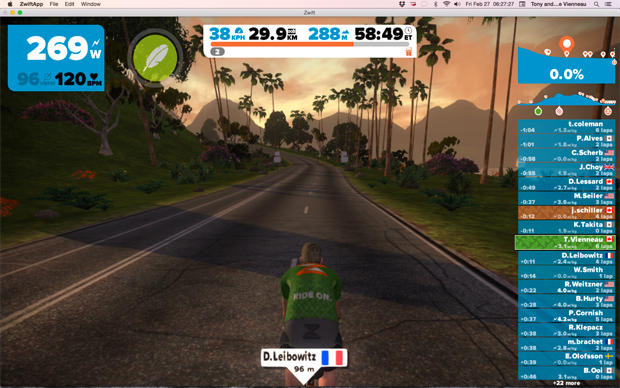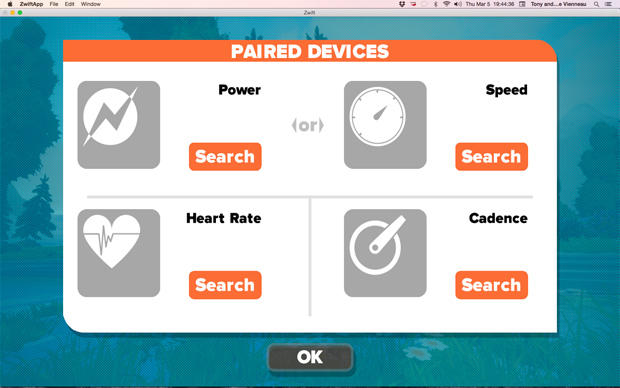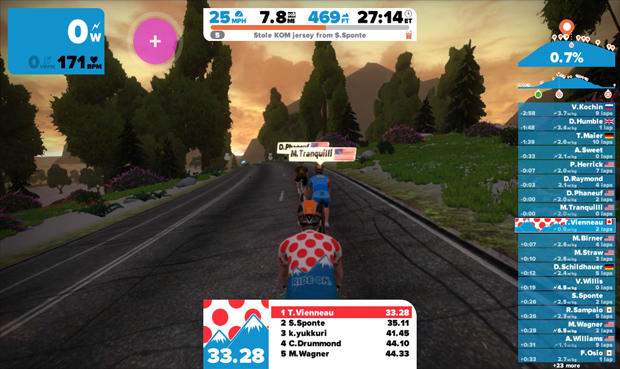Zwift, currently in beta testing, is a new virtual racing platform that is getting a lot of talk lately on the Slowtwitch forums and with good reason. Its unique gaming platform with high-end gaming graphics is revolutionary when compared to virtual racing apps available today.
Beta testing is ongoing on both Windows and Mac platforms and the company has been adding more and more beta testers as they continue to ready its product. Having had a chance to test both platforms, they both appear close to a public release. The requirements to use Zwift are fairly basic: a bike, nearly every type of indoor trainer including some indoor bikes, Ant+ sensor (speed or power), Ant+ dongle (e.g., Garmin 910XT dongle works), and a computer. It is one of the most inclusive systems available. Its website spells out the minimum requirements well and even jokes about how easy it is use to use Zwift. They recommend a newer computer to smoothly run the gaming platform.

Primarily the smooth performance is dependent on your graphics card. I was able to run Zwift on a four-year-old Mac but it was definitely slower and not as crisp as when I tested it on a new Windows PC gaming computer. The noticeable difference was the speed and clarity of the graphics.
Getting started is simple. You log in with your username and password and then are immediately taken to a screen to pair your devices. They are stored in memory so pairing was fast.

After you pair your devices, it is time to personalize. This is where the gaming platform begins. Users can customize their physical appearance, bike, wheel set, and jersey. As you go further in the game—I mean your training—you can earn merit points for certain achievements that unlock special features. Next you start your ride.

This is where Zwift really begins to set itself apart from the competition. It's addicting to race or compete against other Zwifters to earn special features such as the polka dot, green, or orange jersey for having the fastest segment of the day.

Further, as you hit certain power numbers, speed, or miles ridden, you will get a message of your achievement along with unlocking certain jerseys or bike upgrades. I noticed myself time and again pushing harder for these achievements and competing harder than I would under normal training sessions. I also see numerous similar comments from beta users whose easy ride turned into a race or challenge.

During your rides, you can also use "gaming features" such as an "aero boost" that will temporarily rescue your CdA or "lightweight" that will temporarily reduce your mass. Also, your unlocked upgrades (e.g., wheel sets) will also improve the users speed based on the same wattage. Users can also draft during the ride and the interface will help to let riders know when they are in position. These go along with other features such as chatting with other riders or just waving.

Zwift island is about 3 miles long with some decent climbs and descents. The graphics are awesome. The interface is easy to read and there are more and more users so you quite often see over a hundred people riding at one time. You may also see some professional cyclists on Zwift, and Jens Voigt has been on.
Also, there is an active Facebook group (900+ members) called "Zwift Riders" that is probably the best resource for current, or future, beta users. It posts numerous group rides, races, workouts, along with troubleshooting and tips. The group has also composed an unofficial user manual that gets updated as the beta group learns new features. We can expect Zwift to put out a user manual in the future, but until then, this is a great reference. You can also find a Zwift Club on Strava that has some arranged group rides.
At the end of your ride, you get a pretty basic screen that summarizes your current and cumulative ride totals along with how many more points you need till you unlock your next reward. Users also have a dashboard screen with ride information and personal settings.
For those with a Strava account, Zwift will auto import your ride to Strava and for others, you have the option of saving and exporting a .FIT file. Zwift also keeps a copy within the user directory should there be issues. In speaking to Zwift, we can expect the ability to auto import to other sites such as TrainingPeaks in the near future.

Zwift is also beta testing an iOS or Android app. These are not meant to replace the desktop platform but act as a cycling computer with game features during your ride due to the graphics and processing required by Zwift. The app consists of three screens which are a basic dashboard, an action screen, and a list of nearby riders with direct messaging.

I have been impressed with where they currently are in beta testing. There have been some minor glitches where users reported the system crashed, power drops, or power inflation (e.g, 3000 Watts) but most of these have been related to internet or sensor connectivity issues. Zwift hosts a forum for troubleshooting a lot of these problems, as well as fielding feature requests. Overall, Zwift has worked great. The iOS app worked well, and only direct messaging did not seem to be functional.

For all the beta users, the only questions are what's next, and when?
Zwift will be releasing a workout option shortly. In speaking with them, they are holding their cards close to the vest on future plans, but picture doing interval workouts where—instead of looking at your bike computer trying to maintain 400 watts for 5 minute intervals—you are chasing on a route a pace car (or racer) who is programmed for your set intervals; or an FTP test where you input your past result and a pace car or racer automatically goes at that effort for the duration of your test while you try to chase it down and beat your past performance. In the meantime, beta testers have been running TrainerRoad or other software in the background without any issues.
Currently, if users want to organize a group ride or race, they need to find their group from among the many other users on the same route. Zwift will soon have organized group races where competitors will be on a mirror course of Zwift Island, but only registered racers will be on the course. In other words, there could be five Zwift Islands operating at the same time with one for basic training while the other four are organized races or competitions.
Zwift will also be adding at least one new course in the coming months and they will be generating all the courses. Users may also see a velodrome but not until at least 2016, and perhaps some TT bikes and customized jerseys to represent Slowtwitch members in the future.
Overall, Zwift runs amazingly well and more importantly is fun, if one can say that about indoor cycling. They are forecasting a May, 2015 public release which seems reasonable based on how well the system is operating currently. Should Zwift continue to progress on schedule, add new courses and innovative structured workouts as I expect, they will be the game-changer in cycling apps. Although they are waiting to have a more finished product before charging users, one can expect a subscription-based plan that may be in the vicinity of $10-$20 a month, depending on options.
For those who like to suspend their virtual training account during the summer months, this is one of the many features Zwift is examining based on user feedback and feature requests.
You can read more about Zwift on its site, or read or join the discussion about Zwift (approaching 350 posts as of this writing) on our reader forum.


